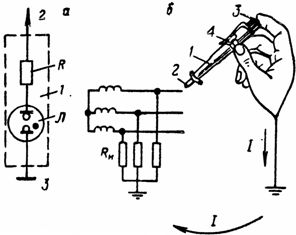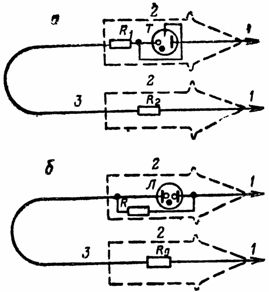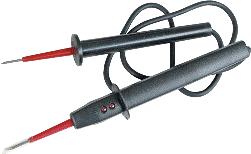Categories: Electrician at home, About electricians and not only, How does it work
Views: 164,439
Comments on the article: 18
Indicator screwdrivers and voltage indicators
With electricity you need to be on you !!! (time-tested wisdom).
Many probably heard that a real electrician is not one that is not afraid of electricity, but one that is able to avoid direct contact with electricity. According to statistics, from electric shock, most often die electricians with experience of ten years or more. It is at this age that a sense of danger is dulled. Some experienced electricians test the presence of electricity by touch, yes, it is by touch. But why risk your own life when there are devices showing the presence of voltage?

There are a lot of devices showing the presence of voltage - from the simplest voltage indicator on a gas discharge lamp (neonka) to devices showing not only the presence of voltage but also many other parameters.
In this article we will consider voltage indicators and indicators, which are most often used in their practice by both professional electricians and home craftsmen. In electrical installations, indicators with signal lamps are most often used.
Relatively recently, we have voltage indicators that allow us to detect the presence of voltage without direct contact with a live conductor.
 An example of this type of instrument is a Chinese-made indicator (although everything is written that is done in Germany) - MS-18, MS-58, etc.
An example of this type of instrument is a Chinese-made indicator (although everything is written that is done in Germany) - MS-18, MS-58, etc.
Such indicators consist of an LED, two miniature batteries and a pair of radio components. These indicators can be used safely, having enough experience and knowledge in electricity, since these indicators respond to everything. For novice electricians and people with no experience, using these probes is undesirable and even dangerous.
 The most popular among beginner electricians and home masters is the indicator screwdriver. Surely such a tool can be found in every home master.
The most popular among beginner electricians and home masters is the indicator screwdriver. Surely such a tool can be found in every home master.
There are many varieties of such a voltage indicator. The simplest ones consist of a neon bulb, resistance from several hundred kOhm to 1 mOhm, a transparent case and a screwdriver blade.
Attention! The indicator screwdriver is pre-checked on a working outlet. During the test, the bright light should not burn, otherwise the light inside the screwdriver will not be visible. When checking, it is necessary to press the special pin on the end of the screwdriver.
Single pole voltage indicators consist of a neon signal lamp with an ignition threshold of not higher than 90 V and additional resistance, placed in an insulated casing that resembles a fountain pen. The housing has contact on the thrust ring side and contact on the head. When checking for voltage, you must touch the contact on the pointer head with your hand. Communication with the earth is through the human body.
To use such a probe, a simple screwdriver is enough to touch the exposed conductor or the current-carrying part of the equipment, use your finger to touch the metal part of the probe, it can be a small ring or just a piece of tin on the cap. In the presence of voltage - the neon bulb lights up. There are a lot of names for such indicators - INO-70, IN-91, etc.
Single-pole voltage indicator type IN-90; IN-91: a - circuit, b - method of use, 1 - insulating body, 2 - probe in the form of a screwdriver, 3 - contact, 4 - hole in the body for monitoring the glow, L - neon lamp type IN-3, R - BC type resistor, 1 MΩ; 0.5 W, R— insulation resistance of network wires relative to earth.
Single pole voltage indicators can be manufactured on their own. The figure shows the data for the manufacture of the voltage indicator UNN-10.An MTX-90 type cold cathode thyratron with an ignition threshold of 90 V was used as a signal lamp.
If it is impossible to obtain a neon lamp or thyratron, it is allowed to use an incandescent lamp with a power of not more than 10 W, enclosed in one of the voltage indicator housings, as an indicator of the presence of voltage. In the second case, an additional wire resistance is mounted. For a 380 V network and a 10 V lamp with a power of 10 W, the value of the additional resistance should be 5000 Ohms.
The next most popular among electricians are bipolar voltage indicators. These indicators consist of two parts. In one of the parts are the entire filling of the device, in the second part is the probe.
Bipolar voltage indicator: a - UNN-10 indicator: b - MIN-1 indicator, T - MTX-90 type thyratron, R1 - MLT-0.5, 1 MOhm shunt resistor, R2 - MLT-2, 0 additional resistor , 24 MOhm, L - glow lamp of type IN-3: R - shunt resistor type BC, 10 MOhm, Rd - additional resistor type BC Z MOhm.
Bipolar voltage indicator consists of a neon lamp, additional resistance and contacts 1. Neon lamp shunted by resistorso that there is no glow under the action of capacitive current. The pointer elements are fixed in two plastic cases 2 connected by a flexible wire 3 1 m long with high reliability insulation.
Bipolar pointers require touching two points of the electrical installation, between which it is necessary to determine the presence or absence of voltage.
There are a lot of varieties of such indicators. In terms of functionality, they also differ.
The simplest indicators only show the presence of voltage. An example of such an indicator is the devices of the PIN-90 series (-2m, -2mu), UN500, -453, UNNU-1, UNN-10, MIN-1, etc. More advanced models - the ELIN-1 series (-СЗ, -С3 ИПМ, -С3 Combi) and many other devices, show not only the presence of voltage in the studied section of the circuit, but also its rating, voltage polarity.
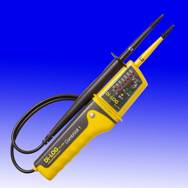 As indications are used: neon bulbs, LEDs of various colors, digital and indicators. There are also combined indicators, where along with the light indication there is also a sound one, which makes working with devices more comfortable and safe.
As indications are used: neon bulbs, LEDs of various colors, digital and indicators. There are also combined indicators, where along with the light indication there is also a sound one, which makes working with devices more comfortable and safe.
Unlike unipolar pointers and indicators, in order to find out about the presence of voltage with these (bipolar) devices, it is necessary to use two probes. The use of such devices gives a more complete picture of the presence or absence of voltage, which is undoubtedly very important in the work of electricians.
In addition to checking for the presence or absence of voltage in the area of the circuit under study, some bipolar indicators can be used as “pro-bells”, that is, to check the circuit for an open.
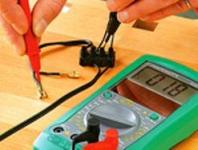 Digital devices are also quite popular among electricians - multimeters - testers. These universal devices allow you to check voltage, resistance, etc. A digital display, sound and light indicators are used as indications.
Digital devices are also quite popular among electricians - multimeters - testers. These universal devices allow you to check voltage, resistance, etc. A digital display, sound and light indicators are used as indications.
Some models are equipped with "Ticks" that allow you to measure currentwithout breaking the insulation of the conductor. Also, many models of testers are equipped with a temperature sensor, with which you can measure the temperature of equipment - transformers, motors, power switches.
Cautions:
1. Use as a voltage indicator warning lamp (a conventional cartridge with two leads) in networks with a linear voltage greater than 220 V is not allowed, since if the cable is switched on incorrectly to a linear voltage in the 380/220 V network, the lamp explodes and fragments can injure a worker.
2. In practice, single-pole voltage indicators are often manufactured on their own, usually in the form of a screwdriver. In this case, there are cases of improper manufacture, and then there is a danger of electric shock. Do not use a screwdriver shaft longer than 20 mm.If the shaft is long, there is a danger of touching it during voltage testing. It is advisable to tightly pull the insulating tube on the rod, leaving a section of no more than 5 mm in length uninsulated. From the side close to the voltage source, there must be a thrust ring protruding 3-4 mm to prevent slipping of the hand.
Particular attention should be paid to the choice of a neon bulb, so that the ignition threshold does not exceed 90 V. The most suitable lamp type IN-3. The additional resistance must be at least 200 kOhm.
The case should be made of ebonite or dark plastic, in which it is easier to notice the glow of the bulb. Manufactured signs should be tested.
In any case, using indicators and voltage indicators, knowledge and skills are needed when working with them. Also, do not forget about safety measures. And, trust the professionals, as you know, electricity does not forgive jokes and mistakes!
See also: How to use a multimeter
See also at i.electricianexp.com
:

